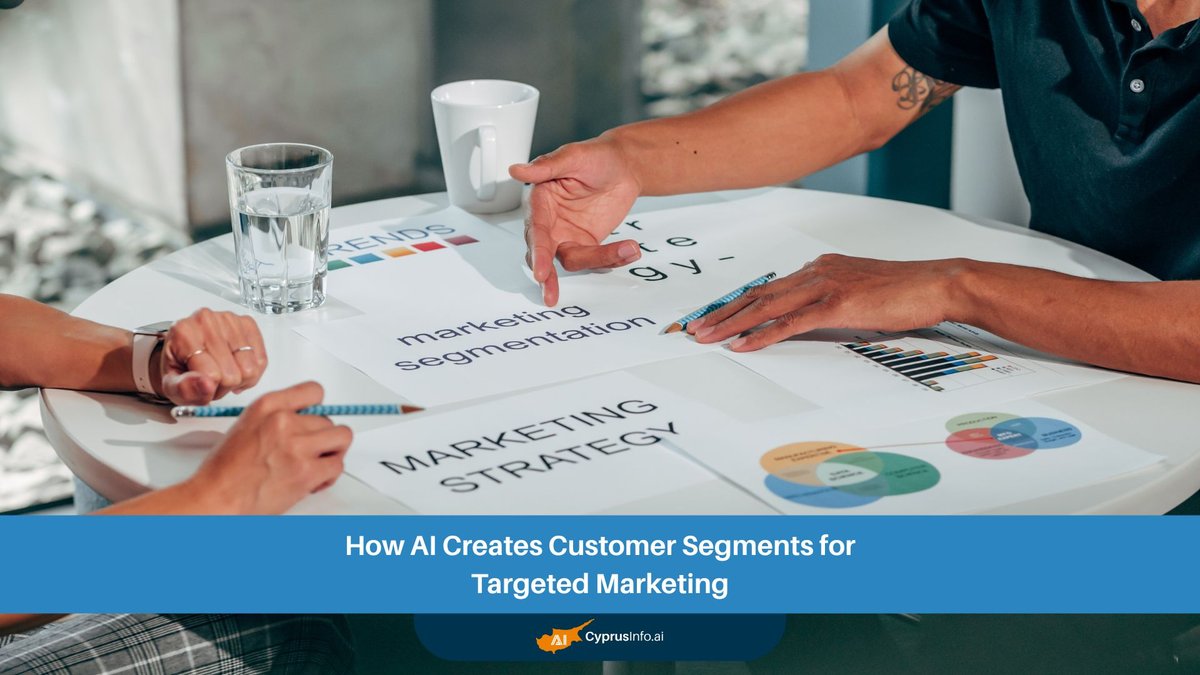In today's fiercely competitive digital landscape, understanding your customer is paramount. Businesses are constantly seeking innovative ways to connect with their audience on a deeper, more personal level. Traditional methods of customer segmentation, while foundational, often fall short in capturing the dynamic and complex nature of modern consumer behavior. This is where Artificial Intelligence (AI) steps in, revolutionizing the way companies approach targeted marketing. By leveraging sophisticated algorithms and vast datasets, AI enables highly precise AI customer segmentation, transforming general audiences into actionable, hyper-personalized groups.
This comprehensive guide will explore the profound impact of AI on customer segmentation, detailing how it works, the various forms it takes, and the immense benefits it brings to businesses aiming for truly targeted marketing. We'll delve into the mechanics of how AI processes data to uncover intricate patterns, moving beyond static demographics to predict future behaviors and preferences. Prepare to discover how AI customer segmentation is not just a trend but a cornerstone for future-proof marketing strategies.
The Evolution of Customer Segmentation: From Traditional to AI-Powered Approaches
Historically, customer segmentation relied heavily on broad categories: demographics (age, gender, income), geography (location), and basic psychographics (lifestyle, interests). Marketers would manually analyze data, often in spreadsheets, to identify common traits among their customers. While these methods provided a useful starting point, they lacked the granularity and predictive power needed for truly effective targeted marketing in an age of abundant data.
Limitations of Traditional Segmentation
Static Nature: Traditional segments are often fixed and don't adapt to changing customer behaviors or market conditions.
Surface-Level Insights: They often miss subtle, yet crucial, patterns and correlations within customer data.
Manual Labor: The process is time-consuming and prone to human error, especially with large datasets.
Lack of Predictive Capability: Traditional methods explain past behavior but struggle to forecast future actions.
As the volume and velocity of customer data exploded, the need for more advanced tools became evident. This is where AI's capabilities shine, enabling a paradigm shift from broad strokes to intricate, dynamic, and predictive AI customer segmentation.
"The future of marketing is not just personalization, but hyper-personalization, driven by the unparalleled analytical power of AI." – Ginni Rometty, Former CEO of IBM
How AI Creates Customer Segments: A Deep Dive into the Process
The magic of AI customer segmentation lies in its ability to process, analyze, and interpret massive amounts of diverse data faster and more accurately than any human. It moves beyond simple rule-based grouping to discover organic, data-driven segments. Here’s a breakdown of the typical process:
1. Comprehensive Data Collection and Integration
AI thrives on data. The first step involves gathering customer data from every available touchpoint. This includes:
Transactional Data: Purchase history, order value, frequency, last purchase date.
Behavioral Data: Website visits, page views, click-through rates, time spent, app usage, email opens, social media interactions.
Demographic Data: Age, gender, location, income (often self-reported or inferred).
Psychographic Data: Interests, preferences, values, opinions (from surveys, social media, content consumption).
Customer Service Interactions: Chat logs, support tickets, call transcripts.
Third-Party Data: External sources to enrich customer profiles.
This data is then integrated into a centralized platform, creating a holistic 360-degree view of each customer. This foundational step is crucial for accurate AI customer segmentation.
2. Data Cleaning and Preprocessing
Raw data is often messy, containing inconsistencies, missing values, and outliers. AI systems employ sophisticated techniques for data cleaning, normalization, and transformation. This ensures the data is accurate, consistent, and in a format suitable for algorithmic analysis, laying the groundwork for reliable AI data analytics for business.
3. Applying Advanced AI Algorithms
This is the core of how AI creates customer segments. Various machine learning algorithms are employed:
AI Algorithms for Segmentation
Clustering Algorithms (e.g., K-Means, DBSCAN): These are unsupervised learning techniques that group customers based on their similarities without predefined categories. They identify natural clusters within the data. For instance, customers with similar buying patterns, browsing habits, or demographic profiles will be grouped together.
Classification Algorithms (e.g., Decision Trees, Support Vector Machines): These supervised learning algorithms predict which segment a new customer is likely to fall into based on learned patterns from existing, labeled data.
Neural Networks and Deep Learning: For highly complex and vast datasets, deep learning models can uncover even more subtle and non-linear relationships, leading to exceptionally nuanced segments.
Association Rule Mining: Identifies relationships between variables (e.g., customers who buy X also tend to buy Y), valuable for cross-selling and upselling opportunities within segments.
These algorithms don't just categorize; they uncover patterns and correlations that would be impossible for humans to detect, enabling precise predictive analytics in marketing.
4. Predictive Analytics for Future Behavior
Beyond current segmentation, AI excels at predictive analytics in marketing. By analyzing historical data and identified segments, AI can forecast future customer actions. This includes predicting which customers are likely to churn (making AI customer churn reduction a real possibility), which are most likely to respond to a particular offer, or what their potential customer lifetime value (CLV) with AI might be. This predictive power makes targeted marketing exceptionally effective.
5. Dynamic Segmentation and Real-time Adjustments
Unlike static traditional segments, AI-powered segments are dynamic. They continuously learn and adapt as new customer data flows in. If a customer's behavior changes – perhaps they start browsing a new product category or engage with different content – AI can automatically re-evaluate their segment placement. This ensures that marketing efforts remain relevant and responsive in real-time.
Key Types of AI-Powered Customer Segmentation
AI customer segmentation enhances and refines all traditional segmentation approaches, offering deeper insights and more actionable groups.
AI vs. Traditional Segmentation Approaches
Segmentation Type | Traditional Approach | AI-Powered Approach |
|---|---|---|
Behavioral | Manual analysis of past purchases, website clicks | Behavioral segmentation AI analyzes real-time clicks, dwell time, pathing, purchase frequency, product views, social engagement; predicts future actions. |
Demographic/Geographic | Basic age, gender, location, income groups | Demographic segmentation AI infers more nuanced attributes from varied data, cross-references with behavioral insights to identify hyper-local or micro-demographic trends. |
Psychographic | Survey data, focus groups, general inferences | Psychographic segmentation AI analyzes language patterns, content consumption, social media sentiment, purchase history to infer interests, values, lifestyles, and personality traits. |
Needs-Based | Product usage, stated needs | AI identifies unspoken needs through complex behavioral analysis and predictive modeling, anticipating needs before customers express them. |
Value-Based (CLV) | Historical revenue contribution | Customer Lifetime Value (CLV) with AI accurately predicts future value, identifies high-potential customers, and pinpoints churn risks based on hundreds of variables. |
Behavioral Segmentation AI
This is arguably where AI brings the most transformative power. Instead of just knowing what a customer bought, behavioral segmentation AI tracks how they interact with your brand across all digital touchpoints. This includes detailed website navigation paths, specific products viewed (and for how long), items added to cart (and abandoned), email engagement, app usage patterns, and more. AI identifies cohorts with identical or similar behaviors, allowing for highly specific personalized marketing strategies.
Demographic and Geographic Segmentation AI
While seemingly basic, AI refines these segments. It can identify subtle correlations between demographic traits and behaviors that traditional methods would miss. For example, it might find that young professionals in specific urban areas respond exceptionally well to certain types of digital advertising, or that certain product preferences are highly localized, improving targeted marketing efforts for specific regions.
Psychographic Segmentation AI
Traditionally challenging, psychographic segmentation AI delves into customer lifestyles, values, interests, and personality traits. By analyzing textual data (e.g., customer reviews, social media posts) and behavioral data (e.g., content consumption, browsing habits), AI can infer deeper psychological profiles. This allows marketers to craft messages that resonate with core beliefs and aspirations, driving genuine connections.
Needs-Based and Value-Based Segmentation
AI can identify customers with similar underlying needs, even if their surface-level demographics differ. Furthermore, by calculating customer lifetime value (CLV) with AI, businesses can segment customers based on their potential long-term profitability. This enables allocation of resources to nurture high-value customers and strategically engage those with high potential.
The Unparalleled Benefits of AI Customer Segmentation for Targeted Marketing
The adoption of AI customer segmentation brings a cascade of advantages that directly impact marketing effectiveness and overall business growth.
1. Hyper-Personalization at Scale
AI enables marketers to move beyond simple personalization to hyper-personalization with AI. Each segment, and even individual within a segment, can receive highly relevant messages, product recommendations, and offers. This level of customization fosters a deeper connection and significantly improves conversion rates. For instance, an AI might detect a customer in Limassol who frequently browses luxury real estate and then target them with bespoke investment opportunities in that area.
2. Improved Campaign ROI and Efficiency
By targeting the right customers with the right message at the right time, marketing spend becomes far more efficient. AI reduces wasted ad impressions and improves conversion rates, leading to a higher return on investment (ROI). Businesses can achieve better results with the same, or even less, marketing budget, making every campaign count, as highlighted in our AI's guide to mastering digital advertising.
3. Enhanced Customer Experience
When customers feel understood and receive relevant communications, their experience with a brand improves dramatically. This leads to increased satisfaction, loyalty, and positive word-of-mouth. AI-powered customer insights lead to experiences that feel intuitive and anticipate needs, building stronger relationships.
4. Optimized Product Development and Service Delivery
Understanding granular customer segments provides invaluable insights for product teams. AI can highlight underserved segments, pinpoint desired features, or identify gaps in the market, guiding the development of new products and services that truly resonate with specific customer groups. This is a critical aspect of AI-powered business advisory.
5. Faster Market Response and Competitive Advantage
The dynamic nature of AI customer segmentation means businesses can quickly react to market shifts or emerging customer trends. This agility provides a significant competitive advantage, allowing companies to be proactive rather than reactive in their marketing strategies, as seen in advanced AI competitive analysis.
Implementing AI Customer Segmentation: Best Practices and Challenges
While the benefits are clear, successful implementation of AI customer segmentation requires careful planning and execution.
Key Points for Successful AI Customer Segmentation Implementation:
Start with Clear Objectives: Define what you want to achieve with segmentation (e.g., increase conversions, reduce churn, improve CLV).
Prioritize Data Quality: "Garbage in, garbage out" applies directly to AI. Invest in robust data collection, cleaning, and integration processes.
Iterative Approach: Don't expect perfection from day one. Start with simpler models, test, learn, and continuously refine your segments and strategies.
Ethical Considerations: Ensure data privacy (e.g., GDPR compliance, especially important for firms in Cyprus as detailed in data protection GDPR compliance for Cyprus firms) and transparency in how AI is used for segmentation. Avoid bias in algorithms.
Cross-Functional Collaboration: Successful implementation requires collaboration between marketing, IT, data science, and sales teams.
Challenges often include data silo issues, integrating new AI tools with existing marketing technology stacks, and the need for skilled personnel to manage and interpret AI outputs.
CyprusInfo.ai: Empowering Your AI-Driven Marketing
At CyprusInfo.ai, we understand the critical role of advanced technology in modern business success. Our platform is designed to empower businesses, particularly those operating in or looking to engage with the Cypriot market, with cutting-edge business investment tools and insights. We help you navigate the complexities of data to achieve superior AI customer segmentation. Whether you're a startup looking to generate qualified leads or an established enterprise aiming for unparalleled AI customer experience, our AI-powered solutions can transform your marketing efforts.
Leverage our AI-powered marketer and business adviser to identify lucrative customer segments, craft compelling ad copy, and optimize your digital advertising strategies. Our platform helps local businesses master their market by providing deep, actionable AI-powered customer insights, driving effective targeted marketing campaigns and unlocking significant growth opportunities within Cyprus and beyond.
Frequently Asked Questions About AI Customer Segmentation
What is AI customer segmentation?
AI customer segmentation uses artificial intelligence and machine learning algorithms to analyze vast amounts of customer data, grouping individuals into distinct segments based on shared characteristics, behaviors, and predictive traits. This goes beyond traditional methods by identifying more nuanced and dynamic groupings.
How does AI improve traditional segmentation?
AI improves segmentation by enabling deeper analysis of complex, high-volume data, identifying subtle patterns, predicting future behaviors, and allowing for dynamic, real-time adjustments to segments. It provides a level of precision and scale that manual methods cannot match.
What types of data does AI use for segmentation?
AI uses a wide array of data including transactional (purchase history), behavioral (website clicks, app usage), demographic (age, location), psychographic (interests, values), and interaction data (customer service logs, social media engagement).
Can AI predict customer churn through segmentation?
Yes, one of the powerful applications of AI customer segmentation is its ability to identify segments of customers at high risk of churn. By analyzing patterns associated with past churned customers, AI can predict which current customers are likely to leave, allowing for proactive retention strategies.
Is AI customer segmentation ethical?
AI customer segmentation can be ethical if implemented responsibly. Key considerations include ensuring data privacy and compliance with regulations like GDPR, avoiding discriminatory biases in algorithms, and being transparent with customers about data usage. The goal is to enhance customer experience, not exploit data.
What are the main benefits for targeted marketing?
The primary benefits for targeted marketing include achieving hyper-personalization at scale, significantly improving campaign ROI, enhancing the overall customer experience, optimizing product development based on real needs, and gaining a competitive edge through faster market responsiveness.
How can a small business leverage AI for customer segmentation?
Small businesses can leverage AI through affordable cloud-based marketing automation platforms that incorporate AI segmentation features, using AI-powered CRM systems, or partnering with platforms like CyprusInfo.ai that offer accessible AI tools to analyze their customer data and define segments.
What is hyper-personalization with AI?
Hyper-personalization with AI refers to delivering highly individualized content, product recommendations, and experiences to each customer, often in real-time, based on their unique data profile and predicted preferences. It's a much more granular and dynamic form of personalization than traditional methods.
How does AI help with customer lifetime value (CLV) calculations?
AI significantly enhances CLV calculations by using predictive models to forecast future customer behavior and spending more accurately. It considers a vast array of variables, including historical purchases, engagement levels, and demographic data, to provide a more robust CLV estimate for better segmentation and resource allocation.
What are the initial steps to implement AI customer segmentation?
The initial steps involve defining clear marketing objectives, auditing and integrating all available customer data sources, ensuring data quality and readiness, selecting appropriate AI tools or platforms, and starting with pilot projects to test and refine your segmentation models before full-scale deployment.
Conclusion: The Future of Targeted Marketing is AI Customer Segmentation
The ability of AI to dissect complex datasets, identify subtle patterns, and predict future behaviors has fundamentally reshaped customer segmentation. By moving beyond rudimentary groupings to create dynamic, data-driven segments, businesses can achieve unparalleled levels of personalization and targeting. This precision not only optimizes marketing spend and boosts ROI but also cultivates stronger customer relationships built on relevance and understanding. As AI technology continues to advance, AI customer segmentation will become an even more integral and indispensable tool for any organization aspiring to truly understand, engage, and delight its customers in the digital age. Embracing AI is no longer an option but a strategic imperative for sustained growth and competitive advantage in modern marketing.



